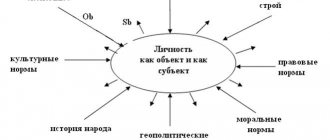A stuck personality type is an interesting character accentuation that contains both positive and negative traits. The quality of human life depends on their correct implementation. To do this, the “stuck” individual needs to carry out considerable psycho-correctional work on himself.
Mistrust is one of the main features
What is a stuck personality type?
Getting stuck in psychology is a mental state in which a person lingers on some feeling or event for a long time.
Additional Information. The following expressions are considered popular synonyms for this phenomenon: “sticky state” and “lingering character.”
Most often, such behavior is observed in affectively stagnant people of the paranoid type of accentuation. The stuck type of personality represents such an accentuation of character, which is characterized by excessive stability of affect.
Stuck-type thoughts are destructive for the individual himself.
Additional Information. Whatever emotions a person experiences, they should subside over time. After all, a discharge has occurred, negative or positive feelings have come out.
For people with the stuck type, this process proceeds differently: after a while, the affect does not end. As soon as a person mentally returns to the situation, emotions begin to rage again.
Features of the stuck type of personality accentuation
Cognitive personality disorders - what does it mean?
The affective-stagnant personality type, which is characterized by being stuck, has a number of features. Among them are the following paranoid manifestations:
- Touchiness is a striking feature of people with a stuck type of accentuation.
- Grudge. A person is capable of being “stuck” for a long time in the grievances inflicted on him.
- Conflict. Representatives of the paranoid type will not miss the opportunity to enter into a quarrel with the offender at any opportunity.
- Affectively stagnant individuals endure the ups and downs that life provides for a long time. It is difficult for them to get rid of mental torment.
- There is a clear division between friends and enemies. In this case, people can quickly fall from a positive group to a negative one.
- Due to excessive suspicion, thoughts of unfair treatment are often generated in the head of a stuck person. In fact, these can only be speculations that have nothing to do with reality.
- The thinking of such people is immature, childish, prone to fantasy.
- In the love sphere, affectively stagnant individuals are pathologically jealous.
- Often people with a stuck type of accentuation have increased demands on themselves and others.
- Positive character traits include endurance, ambition and perseverance. These traits help people of this type achieve high results in the professional field.
Due to the constant increase in affect, a person can experience both long-term defeats in creative and work activities, and outstanding successes.
Constant swing of ups and downs
Important! Due to the continuous change of falls and satisfaction, people with a stuck type of accentuation develop a paranoid affect.
If the persistence of thoughts is too long, a person may develop overvalued or delusional ideas.
General characteristics of the properties of the nervous system and human temperament
As you know, there are no two people on Earth with the same skin patterns on their fingers, and there are no two completely identical leaves on a tree. In the same way, in nature there are no absolutely identical human personalities - the personality of each person is unique and inimitable.
However, a person is not born with an already formed personality. He becomes one gradually. But even before a person becomes an individual, he has individual characteristics that are manifested in behavior, activity, life, and various types of activity: emotional, intellectual, volitional, motor, communicative, etc. These mental characteristics are very conservative and stable. Changing much more slowly than the personality properties known to us, they form in each person a unique psychological soil, on which subsequently, depending on its characteristics, personality properties inherent only to this person “grow.” This means that the child’s psyche is not like a smooth board on which any patterns can be written, and that in the process of raising and teaching a child one must rely on the properties he has from birth. These properties are different for everyone.
Such stable and inherent individual properties of a person from birth are physiological properties such as the nervous system and their psychological manifestations - properties of temperament. What makes them unique? Imagine two rivers: one calm, flat, the other fast, mountainous. The flow of the first is barely noticeable, it smoothly carries its waters, it does not have bright splashes, stormy waterfalls, or dazzling splashes. The course of the second is the complete opposite. The river rushes quickly, the water in it rumbles, seethes, bubbles and, hitting the stones, turns into shreds of foam. The flow characteristics of these rivers depend on a number of natural conditions.
Something similar can be observed in the dynamics (features of the flow) of the mental activity of different people. For some people, mental activity proceeds evenly. Such people are always outwardly calm, balanced and even slow. They rarely laugh, their gaze is always stern and cold, their movements are stingy and expedient. Finding themselves in difficult circumstances or in a “ridiculous” situation, these people remain outwardly unperturbed. Their facial expressions and gestures are not varied and expressive, their speech is calm, their gait is firm. For other people, mental activity occurs spasmodically. Such people, on the contrary, are very active, restless, noisy, and always lively. Their speech is impetuous and passionate, their movements are chaotic, their facial expressions are rich and varied. Often, even in ordinary conversation, their words are accompanied by gestures - a person waves his arms, stamps his feet. They are always fussy and impatient. In other words, the properties of the nervous system and temperament are those that are natural, i.e. innate properties that determine the dynamic side of human mental activity [4].
A scientific explanation of their nature was given by Academician I.P. Pavlov in the doctrine of the basic properties of the nervous system. He identified the following three main properties: 1) the strength of the process of excitation and inhibition, depending on the performance of nerve cells; 2) balance of the nervous system, i.e. the degree of correspondence between the excitation force and the braking force (or their balance); 3) mobility of nervous processes, i.e. the rate of change from excitation to inhibition, and vice versa. I.P. Pavlov found that temperament does not depend on any one of these properties, but on their combination. He called this combination of properties of the nervous system, which determines both the individual characteristics of conditioned reflex activity and temperament, the type of nervous system. I.P. Pavlov distinguished four main types of nervous system:
- strong, unbalanced (with a predominance of the excitation process),
- strong, balanced, agile,
- strong, balanced, inert,
- weak.
Identified I.P. Pavlov, the main combinations of properties, or types, of the nervous system, on which temperament depends, are common in humans and animals. Therefore they are called general types. These general types of the nervous system underlie the four traditional types of temperament: choleric, sanguine, phlegmatic and melancholic, which are quite clearly expressed already at school age.
Sanguine.
This is a subject with a strong, balanced, mobile type of nervous system. A sanguine person is distinguished by increased reactivity, which manifests itself in the liveliness with which his emotional nature responds to everything. He is characterized by great activity - he is able to show significant energy, efficiency and perseverance. The activity and reactivity of a sanguine person are balanced - he can restrain feelings and worries. The reaction rate is quite high, so he loves fast movements. A sanguine person is characterized by high plasticity and extroversion, as a result of which he is sociable, easily gets used to new people and conditions, easily moves from one type of activity to another, but is not sufficiently diligent and focused, especially in conditions of monotonous work. During the learning process, he quickly grasps the main points, but makes mistakes. Does not like painstaking and lengthy work to master complex knowledge or develop skills and abilities. He is quite efficient, self-confident, the results of his activities are stable and, as a rule, in important situations (exams, competitions, etc.) are higher than in the situation of a regular lesson or training.
Choleric.
Has a strong, unbalanced (with a predominance of excitation) type of nervous system. He, like the sanguine person, is characterized by high reactivity, activity, and a fast pace of reactions. But his reactivity prevails over activity, and therefore in a difficult situation he easily becomes hot-tempered, abrupt, and quickly loses his temper. Like a sanguine person, he loves fast movements, willingly and enthusiastically begins to engage in his chosen activity, but quickly cools down. Does not like long and monotonous work. His results are not stable enough, because he is prone to excessive excitement before starting responsible work, which often does not allow him to fully realize his capabilities.
Phlegmatic person.
This is a person with a strong, balanced, inert type of nervous system. Unlike sanguine and choleric people, he has little reactivity, so it is difficult to anger him. Minor emotional excitability allows him to remain calm before serious, responsible work. High activity prevails over low reactivity, which determines patience, endurance and self-control. A phlegmatic person's movements and speech are slow, reactions are delayed. He is characterized by rigidity and introversion, which determines the stability of habits and skills, and low sociability.
Melancholic.
A subject with a weak type of nervous system. The most characteristic of it is high sensitivity, manifested in painful sensitivity and vulnerability. Low reactivity and reduced activity contribute to the fact that he is easily “lost”, quickly gets tired, and lacks self-confidence. The melancholic person is responsible, but is not efficient enough and is not resistant to external stimuli. High anxiety often gives rise to self-doubt and low self-esteem. In a situation of responsible work, a melancholic person, as a rule, shows less good results than in the course of everyday activities.
Causes
How to love yourself - what does this mean in psychology, acceptance of your personality
The exact reasons that cause the development of psychopathology are not known. There are several views describing the process of its emergence. According to the first theory, the formation of a stuck character of the paranoid type is a genetic predisposition.
Additional Information. Scientists have found that twins exhibit paranoid traits to almost the same extent. This suggests a hereditary predisposition to the paranoid type.
Quite often, the stuck type of accentuation occurs in those people whose close relatives suffered from mental disorders. The disadvantage of this theory is the inevitability of the situation. According to psychoanalytic theory, the stuck character of the paranoid type is formed in early childhood.
Strict upbringing
Important! This is especially true for children who were raised in authoritarian families, where there was strictness, exactingness, humiliation and physical punishment.
Because of this approach to upbringing, the child gradually lost trust, first in his parents, then in other people. During the period of growing up, such a child gradually develops a defense mechanism consisting of aggression and distrust. There is also a habit of blaming the people around you for all failures.
How it manifests itself
Epileptoid personality type
Getting stuck in psychology is characterized by a whole set of symptoms that one has to deal with every day. They negatively affect a person's life.
Additional Information. The first symptoms are noticeable at an early age. Such children often overestimate their abilities, are characterized by excessive straightforwardness, stereotypical thinking and a disdainful attitude towards the feelings and interests of other individuals.
Fight for justice
Psychologists describe the following typical manifestations of accentuation in adulthood:
- It is difficult for a person to establish trusting and close relationships with people.
- Because of the fear of being offended or deceived, an individual prefers to refuse acquaintances, choosing loneliness.
- Often such people are left without a partner due to excessive pedantry and pronounced egocentrism.
- A stuck personality type often faces psychosomatic problems: diseases of the gastrointestinal tract, headaches, hypertension and dysfunction of the reproductive system. This occurs due to constant tension and the inability to recognize stress.
- A representative of the stuck type is unable to find mutual understanding with children. This is especially true for children under 5 years of age. An affectively stagnant person values the truth, so in a conversation with a child he will stubbornly prove it. It is important for children in a three-year-old crisis to feel smart and reasonable. Such a clash of two views can cause moral injury to both one and the other interlocutor.
- A stuck person has difficulty talking about himself. Due to the fact that such people do not peer into the depths of their personality, they are able to characterize their own person only in activity.
- Due to persistence and thirst for justice, a person constantly fights with people through complaints, letters and lawsuits.
Such symptoms often lead affectively stagnant individuals to depression, as well as the development of compulsive-obsessive and anxiety disorders.
DYSTHYMIC PERSONALITIES
Dysthymic temperament (with a more severe manifestation, subdepressive) is the opposite of hyperthymic. Personalities of this type are serious by nature and usually focus on the gloomy, sad aspects of life to a much greater extent than on the joyful ones. Events that have deeply shaken them can bring this serious pessimistic mood to a state of reactive depression, especially in cases where there are pronounced subdepressive features. Stimulation of vital activity in dysthymic temperament is weakened, thought works slowly. In society, dysthymic people hardly participate in conversation, only occasionally inserting remarks after long pauses.
A serious mood brings to the fore subtle, sublime feelings that are incompatible with human egoism. A serious attitude leads to the formation of a serious ethical position. It is already significant that in both cases we use the definition “serious”. This indicates an internal closeness between these manifestations. It is in them that we see the positive side of dysthymic temperament. Passivity in actions and slow thinking, in cases where they go beyond the norm, are among the negative properties of this temperament.
Subdepressive temperament is easy to connect with depressive mental illness, but, as with hyperthymia, this connection is by no means necessary. This temperament very often corresponds to the mental norm.
I give one of the descriptions from our collective work (doctor Unger).
Horst H., born 1931 The father is a calm, reserved person. The mother is more lively by nature, but is constantly sick. X. has two brothers, both of whom are more relaxed than X.
Already as a child, X. was very reserved. Studying was not easy, but conscientiousness helped; X. was not a repeater. He did not have a close friend at school, as, indeed, in subsequent years. X. considered his fellow students to be hooligans and was indignant when they did not take the teachers’ demands seriously. At home he loved to tinker and dreamed of becoming a cabinetmaker, but after graduating from school he received a place as a turner's apprentice. A year later he left this job, after which he worked as a laborer until 1949. In 1949 he began working in the mining industry and became a foreman. On weekends, he preferred solitary long walks to the entertainment enjoyed by his workmates; in winter he went skiing alone. After a year and a half, they wanted to transfer him to another mine, but he refused, because this mine had a bad reputation, and went to work as an auxiliary worker. Two friends convinced him to apply to police school.
X. graduated from the school of police officers (albeit with C grades) and became the head of the unit. His work did not satisfy him in any way, he did not like to command, did not like to overcome someone's resistance. “There was no joy in the work,” he said, “and life itself seemed meaningless.” At X.'s request, he was transferred to a unit with fewer people. However, the opinion at work about him was good. X.'s greatest desire was to move to another job, but police discipline did not allow this.
The first intimate relationship with the girl lasted 2 years. He left her for the reason that she used to tell him about invitations from other men. “What especially hurt me was that she was so flattered by it, that she was so proud of it,” said X.
In 1962, he married someone the same age, but he and his wife “didn’t get along.” His wife always dragged him to dances and group outings in the countryside, but he preferred to stay at home with the children. If his wife invited guests, he remained silent the entire evening. He preferred solitude and a book to any reception. “But I don’t blame her, her nature is different.” In 1965, “by mutual consent,” they filed for divorce. His wife invited him to live in the same apartment after the divorce (“it’s easier to look after the children together”), X. agreed. He explained it this way: “The hopes still did not come true, whether I leave or stay - this, in essence, does not change things.” He decided that he would move out of this apartment if his wife found a new life friend.
X. peppered his story about himself with the following remarks: “I always see the bad in everything,” “I’ve never had a really good life,” “I can’t communicate with anyone, I’m somehow inferior.” At first he refused to talk about himself at all: “What is this for?”
This person undoubtedly has positive traits. He takes his responsibilities seriously, no matter where he works, they are always happy with him. He is tactful and fair. But lack of activity prevented him from organizing his life in such a way as to feel satisfaction. A constant pessimistic attitude aggravates the situation; the subject tries to “start something else”, to join a new profession, but does not find joy or even balance.
Characteristics of temperament can, as a rule, be established already in childhood. Hyperthymic temperament in children is easy to determine, perhaps easier than in adults, since the natural liveliness of children is accompanied by liveliness of temperament. In my work “Children's Neuroses and Children's Personality” I described such “super-active”, “super-fast” children. Dysthymic temperament in children is also easy to recognize. Such children stand out from others by their timidity and indecisiveness. This is evidenced by the case described by Zeller in our book.
Karl S., 12 years old. He came to us to undergo a course of inpatient treatment. The mother is an unbalanced woman, “she sometimes cries and sometimes laughs,” and is sometimes strict and self-possessed. My father is a baker, a lively person by nature, a conscientious worker. The mother constantly helps in the bakery, the father goes to bed very early (due to working conditions), so the children are essentially left to their own devices.
Of the six children, Karl is the quietest and slowest, although he can hardly be called timid. The boy is always very serious, never laughs heartily. With strangers, Karl is timid, shy, and begins to stutter. He is afraid to go shopping: “you have to talk to the sellers there.” Neat in clothes. He often quarrels with his older brother, whom his parents love more than him, and then his brother and his friends beat him.
Karl had a hard time at school; he even repeated the second year once. He studied conscientiously, but it took twice as much time to prepare his lessons as other children. In class everyone made fun of him, no one ever defended him. He was friends with elementary school students: “they are not so impudent and do not fight.”
In the department, Karl was timid, inhibited, constantly depressed, and tears often came to his eyes. There was no trace of childish laughter or cheerfulness; he spoke very quietly. He was often offended by children, but easily came to reconciliation. I was sincerely grateful for any kind of attention. Questions about his older brother made him very excited. Our children's team did not “accept” him. Karl was happy when he found a boy who became friends with him. He submitted to this boy in everything, for his sake he even committed offenses that he himself condemned (missing classes at the school at the clinic). Age-related intelligence indicators, determined by special tests, are normal.
Karl exhibits the whole complex of subdepressive temperament. He does not have childish carelessness or gaiety; he rather gives the impression of a depressed child. Added to this is slowness and clumsiness. His thinking is probably slow, as evidenced by his poor performance at school. Despite his normal intelligence, depression and slowness of reactions caused him to lag behind his peers. Therefore, Karl’s peers made fun of him, but he was angry and offended by them.
Diagnostics and correction
Diagnostic measures aimed at establishing an accentuated personality can be implemented using various questionnaires and tests. For example:
- Personality questionnaire of G. Smishek. It includes 88 questions. The subject must answer “Yes” or “No” to each of them. There are 2 types of this questionnaire: for adults and children. They are the same, only in the version for kids the questions are described in a different form.
- The A.E. questionnaire is suitable for diagnosing adolescents aged 14-18 years. Lichko. Thanks to objective scales, it will be possible to establish not only the type of character accentuation, but also to determine psychopathy.
- To establish the degree of aggressiveness, a psychologist can use the test of A. Darkey and A. Bass. Of the 75 statements, it is necessary to establish which options are most typical for the subject.
- The methods of R. Cattell will help you study the structure of personality. They contain 2 versions of the questionnaire: for children and adults.
- The K. Thomas questionnaire will help you check conflict levels.
Treatment of a person with a stuck type of accentuation can be carried out with the help of a psychotherapist. The shortest course is 5 meetings.
Important! The main goal of therapeutic sessions will be to teach an affectively stagnant individual to use character traits for good purposes.
Appointment with a psychologist
It is difficult for such individuals to work with a psychologist, since they are constantly waiting for confirmation that they are right. You can learn to control feelings and emotions, as well as correct your own reactions to stimuli on your own. To do this, psychologists advise starting in-depth work on yourself using the following recommendations:
- It is necessary to constantly separate your own fantasies from reality. This requires asking possible offenders why they committed this or that act, and whether their goal was really to cause damage.
- You need to communicate with people more often. The more a person learns about the lives of other individuals, their reactions, motives, the better he will understand them.
- It is important to study child psychology, which will allow you to build friendly relationships with kids. Pleasant communication with your child will allow you to learn to look at the world with an open mind.
- You need to think positively. As an exercise, you should try every day to extract the positives from a bad situation. Gradually this will become a habit.
- It is necessary to try to justify any behavior of people. This will allow you not only to moderate your own ardor, but also to understand the person’s motives.
If the positive aspects of character are not developed, the individual will turn into an antisocial personality. It is better to identify accentuations in childhood - this will help to carry out corrective work in a shorter time.
Bibliography
- Vyatkin B.A., Shchukin M.R. Psychology of human styles: textbook. allowance / Ross. acad. education; Perm. state humanit.-ped. univ. - Perm: Book World, 2013. - 128 p.
- Vyatkin B.A., Shchukin M.R. Man - style - society: polysystem interaction in the educational space: monograph. - Perm, 2007. - 108 p.
- Merlin V.S. Essay on an integral study of individuality. - M.: Pedagogy, 1986. - 256 p.
- Merlin V.S., Vyatkin B.A. Temperament // General psychology: textbook. for pedagogical students Institute / ed. prof. A.V. Petrovsky. — 2nd edition, add. and processed - M.: Education, 1976. - P. 405–421.
- Psychological service in modern education: workbook / ed. I.V. Dubrovina. - St. Petersburg: Peter, 2009. - 400 p.
- Psychology of integral individuality: Perm school / comp. B.A. Vyatkin, L.Ya. Dorfman, M.R. Shchukin. - M.: Smysl, 2011. - 636 p.
- Sambikina O.S. The relationship between the development of the style of educational activity and the integral individuality of junior schoolchildren and adolescents // Polysystemic study of human individuality / ed. B.A. Vyatkina. - M.: PER SE, 2005. - pp. 165–172.
Source: Vyatkin B.A., Sambikina O.S. Types of the nervous system and temperament as natural prerequisites for the formation of a student’s style of educational activity // Bulletin of the Perm State Humanitarian-Pedagogical University. Series No. 1. Psychological and pedagogical sciences. 2014. Vol. 1. pp. 81–100.
September 22, 2021 is the anniversary of Oksana Semyonovna Sambikina , head of the Department of Theoretical and Applied Psychology of the Faculty of Psychology, head of the master’s program “Family Psychology and Family Counseling” at Perm State Humanitarian Pedagogical University. “Psychological Newspaper” congratulates Oksana Semyonovna and wishes her health, inspiration and strength for the implementation of all creative and scientific plans!
Video
Tool for combing the hair of cats and dogs My Rules (deshedder, comb, slicker) size M
711 ₽ More details
History of Russia for children. Book Butromeev V.P. | Butromeev Vladimir Petrovich
888 ₽ More details
Nipple drinkers for rabbits









